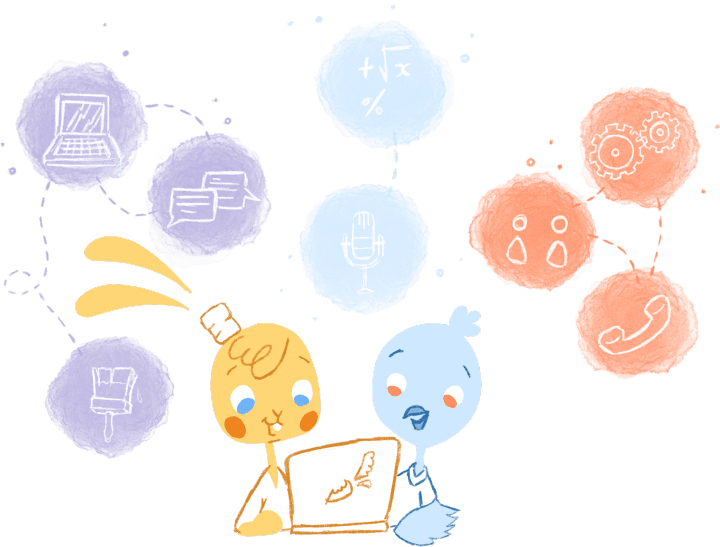

No matter how hard you try, you’re bound to get distracted sometime during the workday. One study from Poly found that 99 percent of employees report they get distracted while working at their personal workspace. And, when a team member gets distracted — productivity suffers.
While there are distractions that you have no power over, there are still plenty of ways that you can help your team avoid interruptions.
1. Introduce a formal process to handle distractions.
If you notice that your team is being distracted by the same things day in day out, it is time to introduce a process to handle it or reinforce an existing process,” states Ben Brearley.
For example, do “you notice that people in your organization are going directly to a certain helpful team member all the time?” If so, “you may introduce a process where that request is sent to a support queue instead.”
Another alternative would be to “introduce a gatekeeper,” suggests Brearley. The gatekeeper, which could be you, is “effective because it provides a barrier which is inconvenient.” Instead of bothering a colleague, and then can get sucked into a side conversation, they must come to you. That’s enough to make them solve a problem on their own.
2. Set clear goals with specific objectives.
“If you notice that certain employees have slowed down their productivity due to digital distractions, it helps to be transparent and direct about your expectations for their performance,” recommends Freedom Founder and CO Fred Stutzman. “They may not have realized how many times they were being interrupted by notifications and how this could impact their work in the long term.”
Also, when you provide your team with “clear guidelines and measurable targets for them to focus on, you can help motivate them to stay on track.” And, it’s a simple way for them to avoid giving in to common workplace distractions.
3. Redesign the workplace.
While there are some distractions that you can’t control, this is not one of them. This could be the one area that you do have the most influence over. But where to start?
Well, if you have an open office plan, you might want to modify it since they just don’t work. Research “shows that such offices result in 73 percent less face-to-face interaction, and a 67 percent increase in email interaction,” writes Pooja Singh. The reason? “All the distracting noise of an open office causes employees to tune out with their headphones, and they resort to sending their queries to colleagues via email instead of standing in front of them owing to lack of privacy.”
Other ways you can cultivate a less distracting work environment? Reduce sound pollution by asking your team to silence their phones and ditching lousy lightning. Also, provide them with ergonomic furniture like standing desks and let them personalize their workspaces.
4. Institute “no interruptions” time and “no-meeting” days.
Because everyone has their own biological prime times, I recommend that you ask your time when they prefer not to be disturbed. You can do this by conducting a poll or survey or simply just asking them. While this won’t please everyone, it could give you an idea of when to implement “no interruption” periods when your team can not interrupt each other unless it’s absolutely necessary.
Also, because meetings are a leading distraction, only hold them on certain days and decree “no meeting” days. For example, make it a point never to schedule a meeting on Wednesday so that your team isn’t getting pulled away from their work. But, if you must have a meeting, make sure that it’s necessary, short, and concise.
5. Recommend distraction blocking apps.
If your team members don’t have the willpower to ignore desktop or smartphone notifications, then suggest that use apps that block distracting apps or sites at specific times. Options would be Offtime, Freedom, Moment, or RescueTime. Or, if you prefer, you can set time limits on Android or screen time on iOS.
6. Establish a plan for urgent situations.
Even if you’ve suggested to your team that they block out specific times to check their phones or email, they may not be able to resist the temptation. I would say that this is most true when someone needs to be updated on an urgent matter. For example, one of my employees has a mother who is in the hospital and they’re constantly checking their phone for updates.
One way around this, suggests Brian Solis, is to “set up a protocol exclusively for urgent messages.” For instance, you could use “a tool that emits a special sound when something is marked as urgent. An easy-to-use setting on computers, phones, and tablets can block out all other notifications, allowing only urgent messages through.” Solis also recommends “making it possible for anyone in the organization to mark an email as urgent, rather than having all emails from certain senders (such as your boss) show up as urgent.”
The key is to use this sparingly. And, if someone is on vacation, please don’t contact them via email. If it is an emergency, then call or text them.
7. Stop overloading your team.
There are two ways that you can prevent overwhelming your team. The first is to stop throwing too much work they way. It’s a simple way to avoid multitasking and worrying about tasks that aren’t currently a priority. Let them finish what they’ve started before assigning them something else.
The second way is through information overload. That means bombarding them with too much information at one time. Or relying too much on technology which has been known to cause collaboration overload.
8. Allow longer breaks.
Your eyes aren’t deceiving you. As Choncé Maddox explains, granting “your employees longer breaks could work out in your favor.” As stated in a report from Salary.com, “employees who admitted to wasting time at work said that common time-wasting activities were talking with other co-workers (43%), online activities (34%), and texting and on personal phone calls (4%).”
“As you can see, nearly half of the employees that were surveyed said they wasted time by chatting with other coworkers, and over a third said they were browsing online,” adds Choncé. “These are all common time-wasting activities that tempt each one of us during the workday.” The reason? It’s just our mind letting us know that “we need a break to recharge our focus.”
“Instead of trying to force employees to work more, you may get better results by giving a longer break so they can do these time-wasting activities off the clock and recharge for the rest of the workday,” suggests Choncé.
Distractions are inevitable. But, instead of fighting against that urge for a break, encourage your team to increase break time by at least 30 minutes.
9. Allow for flexibility.
Remember how distractions pop-up because it’s a sign that you need a break? Well, sometimes that’s because you’re also working against your peak productivity hours. For instance, if you’re a night owl, then it’s counterproductive to force yourself to wake up early and start working first things in the AM.
But, that’s no all. Flexibility could also mean that your team works when there’s no one else in the office — or at their home if they’re working remotely. Because it’s nice and quiet, they’ll be able to focus without interferences like background chatter or massive smartphone notifications.
10. Provide time management training.
“Some believe that time management training doesn’t work,” writes my Calendar co-founder John Hall. “On the one hand, I can why this is true — particularly in regards to traditional techniques.” However, “I don’t think that means completely tossing this idea out the window.”
“Take, for example, a new hire you just graduated from college.” I doubt “that they were ever taught some necessary time management skills, like how to prioritize, organize, and communicate.” In this case, “you might want to sign them up for a time management course or mentor them in techniques that you find to be effective.”
“Moreover, if they tried out one technique that didn’t work, then suggest they try another,” adds John. Both John and I “personally feel that improving your time management is a process.” That means that you must keep making adjustments “until you develop a system that works best for you.” As such, advise your employees of that and “encourage them to keep trying out different methods.”











John Hall
John Hall is the co-founder of Calendar a scheduling and time management app. He’s also a keynote speaker that you can book at http://www.johnhallspeaking.com.